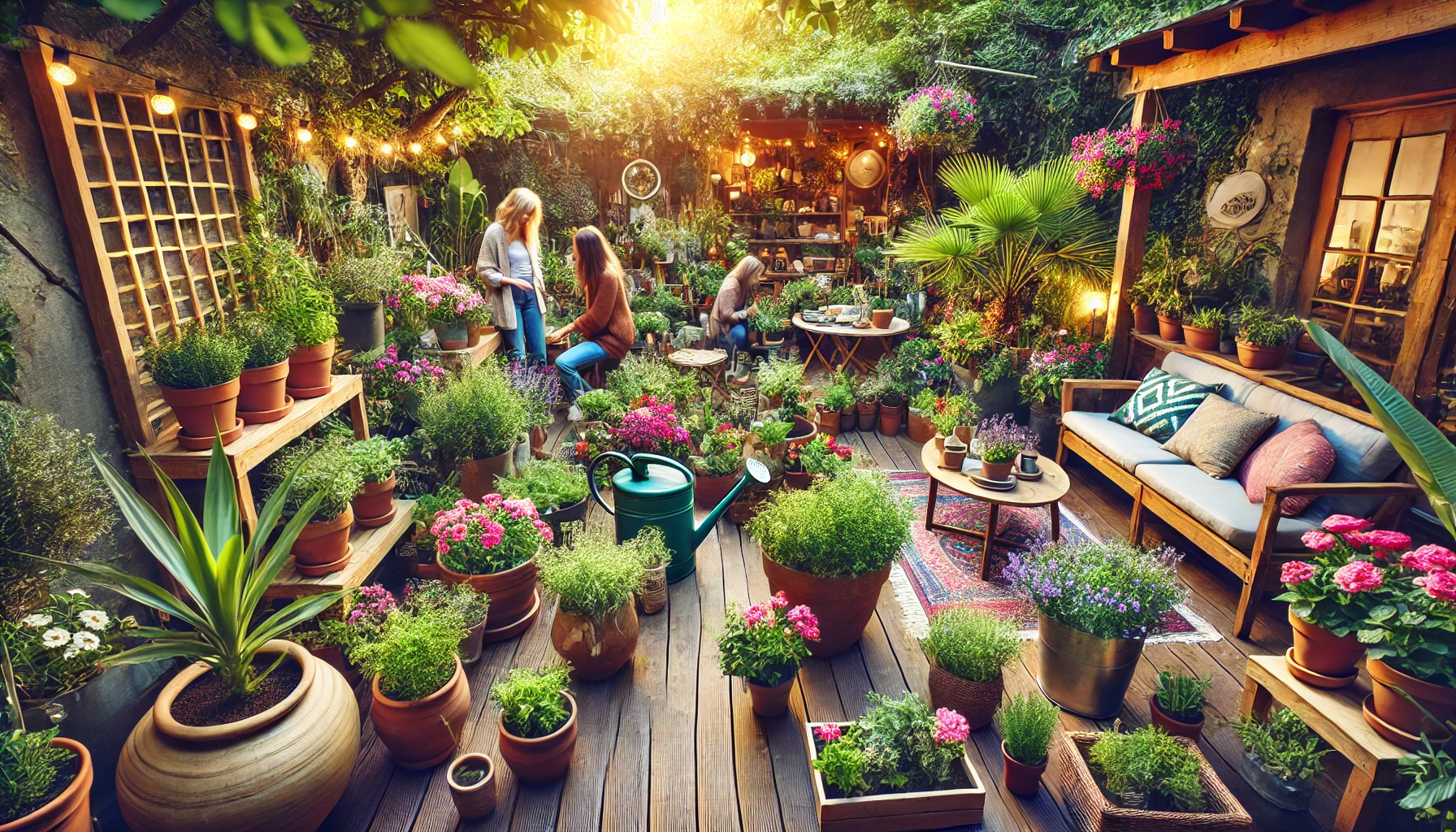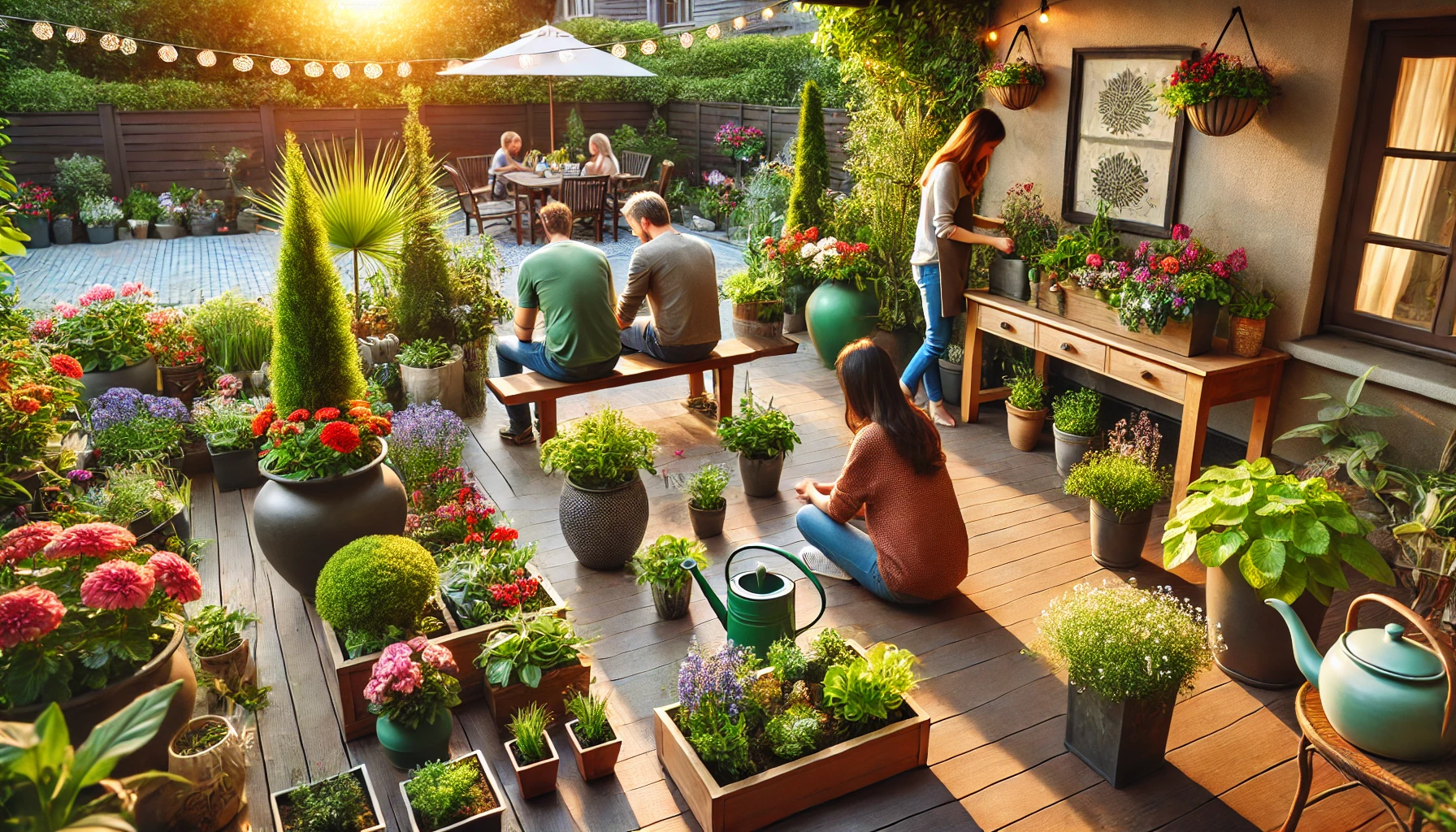Discover the best plants for container gardens to create a stunning oasis, even in the smallest of spaces. Whether you have a tiny balcony, a small patio, or just a sunny window ledge, container gardening allows you to bring greenery into your home without needing a large yard.
Container gardening has surged in popularity in recent years, providing an accessible way for urban dwellers and those with limited outdoor space to enjoy the benefits of plants.
Not only does it offer a way to grow flowers, herbs, and even vegetables in compact areas, but it also helps improve air quality, reduces stress, and adds aesthetic appeal to any environment.
In this guide, we will explore the best plants for container gardening, considering their suitability for confined spaces, ease of care, and ability to thrive with minimal maintenance.
Whether you’re a beginner or an experienced gardener, these tips and plant selections will help you cultivate a beautiful and thriving container garden.
Choosing the Right Plants: What Plants Are Good for Container Gardening?
Selecting the right plants for container gardening is crucial for success. Not all plants thrive in confined spaces, so it’s essential to choose varieties that adapt well to the limitations of pots and planters. Here are some key factors to consider when selecting plants for your container garden:
1. Growth Habit and Size
Since containers provide limited space, opt for plants with compact or trailing growth habits. Avoid plants with extensive root systems unless you have large, deep containers.
2. Light Requirements
Different plants have different light needs. Assess the sunlight exposure of your space and choose plants that match those conditions. For sunny locations, select sun-loving plants like petunias or lavender, while for shaded areas, ferns and hostas are excellent choices.
3. Watering Needs
Some plants require frequent watering, while others thrive on neglect. If you prefer low-maintenance gardening, opt for drought-tolerant plants like succulents or sedum.
4. Climate and Seasonality
Consider your local climate and the changing seasons. If you live in an area with harsh winters, look for hardy perennials or bring your container plants indoors during colder months.
Versatile Plants for Container Gardening
Here are some excellent plants that thrive in containers and adapt well to different conditions:
- Geraniums – Bright and cheerful, geraniums bloom profusely in containers and are easy to care for.
- Ferns – Perfect for shaded areas, ferns add lush greenery and require minimal upkeep.
- Succulents – Ideal for those who forget to water, succulents store moisture in their leaves and thrive in dry conditions.
- Petunias – These vibrant flowers love sunlight and bloom continuously throughout the season.
- Herbs (Basil, Rosemary, Thyme) – Not only do herbs thrive in pots, but they also provide fresh ingredients for your kitchen.
Top Picks: Best Low Maintenance Plants for Planters
If you’re new to gardening or have a busy schedule, low-maintenance plants are the way to go. These plants require minimal care and still flourish beautifully in containers.
1. Lavender
Lavender is a fragrant, drought-tolerant plant that thrives in full sun. It requires minimal watering and repels pests, making it an excellent choice for container gardens.
Care Tips:
- Use well-draining soil and avoid overwatering.
- Place in a sunny spot with at least 6 hours of direct sunlight.
- Prune after blooming to maintain shape and encourage new growth.
2. Sedum (Stonecrop)
Sedum is a hardy succulent that tolerates neglect and thrives in dry conditions. Its fleshy leaves store water, making it a great option for forgetful gardeners.
Care Tips:
- Water sparingly, allowing soil to dry out between waterings.
- Use sandy, well-draining soil.
- Place in a sunny or partially shaded location.
3. Begonias
Begonias are versatile, thriving in both sun and shade. They require minimal upkeep and bloom profusely with vibrant flowers in various colors.
Care Tips:
- Keep the soil consistently moist but not waterlogged.
- Provide filtered sunlight or partial shade for best results.
- Remove dead flowers to encourage new blooms.
4. Snake Plant (Sansevieria)
Snake plants are nearly indestructible and can thrive in low light and with minimal watering. Their upright leaves add a modern touch to any space.
Care Tips:
- Water only when the soil is completely dry.
- Place in indirect light or low-light areas.
- Avoid overwatering, as it can cause root rot.
5. Pothos (Devil’s Ivy)
Pothos is a trailing plant that works well in hanging baskets or as a tabletop accent. It grows quickly and can thrive in low light with infrequent watering.
Care Tips:
- Water when the top inch of soil is dry.
- Trim long vines to maintain a tidy appearance.
- Fertilize occasionally for enhanced growth.
Common Challenges: What Is the Most Common Mistake Made With Container Plants?
Container gardening offers a convenient and space-efficient way to grow plants, whether you have a sprawling backyard or a small balcony.
However, many gardeners, both beginners and experienced ones, often encounter pitfalls that hinder plant growth.
One of the most common mistakes made with container plants is improper watering—either overwatering or under-watering.
Overwatering is particularly prevalent because containers limit natural drainage, leading to waterlogged soil and root rot.
Many plants, especially those not adapted to standing water, suffer from excessive moisture, causing them to wilt or die prematurely.
On the other hand, under-watering can also be a problem, particularly in hot weather or with small containers that dry out quickly. The key to overcoming this challenge is understanding each plant’s specific watering needs and ensuring proper drainage.
To prevent overwatering, always choose containers with drainage holes. Without these, excess water has nowhere to escape, creating an environment conducive to fungal growth and root diseases.
If you already have containers without holes, drill small holes at the bottom or place a layer of gravel beneath the soil to facilitate better drainage. Another technique is using self-watering pots, which help regulate moisture levels by providing water to the roots as needed.
Apart from drainage, selecting the right container size is crucial. Many gardeners make the mistake of using containers that are too small, restricting root growth and reducing the plant’s ability to absorb water and nutrients.
Larger containers provide better soil insulation, reducing fluctuations in temperature and moisture levels.
Lastly, using the right soil mix is essential. Regular garden soil is too dense for containers, preventing proper aeration and drainage. Instead, opt for a high-quality potting mix that contains materials like peat moss, perlite, or vermiculite, which promote proper airflow and moisture retention without water-logging.

Edible Choices: What Vegetables Are Best for Container Gardening?
One of the most rewarding aspects of container gardening is growing your own food, even in limited spaces. Many vegetables thrive in containers, allowing gardeners to enjoy fresh produce straight from their balconies, patios, or even kitchen windowsills.
Some of the best vegetables for container gardening include:
- Cherry Tomatoes – These compact plants are highly productive and grow well in pots as small as 12 inches in diameter. They require staking or cages for support and do best in at least six hours of direct sunlight daily.
- Salad Greens (Lettuce, Spinach, Arugula) – These fast-growing leafy greens thrive in shallow containers and are perfect for small spaces. They grow well in cooler temperatures and can be harvested continuously.
- Peppers (Bell Peppers, Jalapeños, Banana Peppers) – Peppers are well-suited for container gardening as long as they receive adequate sunlight and a container at least 12 inches deep. They prefer warm temperatures and benefit from occasional fertilization.
- Radishes – These root vegetables mature quickly and require minimal space, making them ideal for container gardening. A pot at least six inches deep is sufficient for healthy growth.
- Carrots – While not all varieties are ideal for containers, smaller and rounder types, such as ‘Parisian’ carrots, grow well in pots at least 12 inches deep.
- Cucumbers – Bush varieties of cucumbers are excellent for containers. They require deeper pots and benefit from a trellis or support to encourage vertical growth.
When growing vegetables in containers, space management is key. Grouping compatible plants together in larger containers can maximize space while improving productivity.
For example, pairing salad greens with herbs like basil and parsley creates a productive, space-efficient arrangement.
Container depth is another important consideration. Shallow-rooted plants like lettuce and radishes need only 6-8 inches of soil, while deeper-rooted crops like tomatoes and carrots require containers at least 12-18 inches deep. Ensuring the right depth helps plants develop healthy roots and access nutrients effectively.
Additionally, since containers limit natural nutrient replenishment, regular fertilization is necessary. Using organic fertilizers, compost, or slow-release fertilizers can keep vegetables healthy and productive throughout the growing season.
Conclusion: Creating a Thriving Container Garden
Container gardening is a versatile and accessible way to cultivate plants, whether for aesthetic appeal or homegrown food.
By avoiding common mistakes such as overwatering and selecting inappropriate containers, gardeners can create a thriving plant environment with proper drainage and suitable soil.
Choosing the right vegetables for containers enhances productivity and ensures a steady supply of fresh produce. With options like cherry tomatoes, salad greens, and peppers, even the smallest spaces can become flourishing edible gardens.
Success in container gardening comes with experimentation and learning. Different plants have varying needs, and adjusting watering schedules, container sizes, and soil conditions can improve overall plant health. Beginners and experienced gardeners alike benefit from continuous observation and adaptation.
For further exploration, consider researching plant-specific care guides, joining gardening communities, or experimenting with companion planting techniques.
With patience and creativity, container gardening can be a rewarding and sustainable way to cultivate greenery and fresh food in any living space.
Container gardening is an excellent way to bring greenery and beauty into any space, no matter how small. By choosing the right plants, such as easy-to-care-for lavender, sedum, and begonias, you can enjoy a thriving garden with minimal effort.
Whether you’re growing flowers, herbs, or succulents, following simple care tips will ensure that your container plants flourish throughout the seasons.Start your container garden today and transform your small space into a lush, vibrant oasis!


In addition to herbs and flowering plants, vegetables like tomatoes, peppers, and lettuce are also great options for container gardens. These plants can be easily grown in pots or hanging baskets, making them ideal for small spaces like balconies or patios. When selecting vegetables for container gardens, it’s important to choose varieties that are well-suited to the limited space and can thrive in a container environment. With proper care and attention, container-grown vegetables can produce a bountiful harvest. What do you think of this idea?
That’s a fantastic idea! Container gardening is a great way to maximize space while still growing a variety of fresh vegetables. Tomatoes, peppers, and lettuce are excellent choices since they adapt well to containers and can thrive with proper care. I’d also add that using high-quality potting soil, ensuring adequate drainage, and selecting compact or dwarf varieties can make a big difference in success. Plus, vertical gardening techniques—like trellises for vining plants—can help make the most of small spaces. Have you tried growing any of these veggies in containers before?